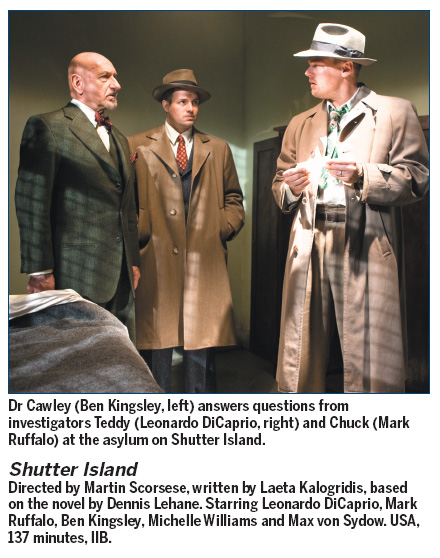The wrong kind of shudder from Shutter Island
Updated: 2010-03-13 07:51
By Elizabeth Kerr
|
|||||||||
Shutter Island is an enigma. How a film directed by Martin Scorsese, one of the greatest filmmakers of all time, photographed by Robert Richardson (a regular for Scorsese, Oliver Stone, and Quentin Tarantino), given form by editor Thelma Schoonmaker (Scorsese's cutter since 1980's Raging Bull), and based on a novel by the tactile writer that penned Mystic River and Gone Baby Gone went off track is baffling. But it did, and far from being "bad," Shutter Island leads you to believe you're going somewhere; that something important is going to happen. When it doesn't - not really - the end result is disappointment. I guess that's better than incompetence-inspired rage.
It's 1954. When a patient apparently goes missing from Ward C, federal marshals Teddy (Leonardo DiCaprio, lacking both the boyishness and the charm that made him a star) and Chuck (a wasted Mark Ruffalo) take their unconvincing New England accents to investigate Shutter Island's Ashecliffe Hospital, some kind of Alcatraz-ish maximum security facility that specializes in housing the "worst of the worst." The prison-like asylum is administered by the possibly duplicitous Dr Cawley (Ben Kingsley) and the shady Nazi, Naehring (Max von Sydow).
The infanticidal woman vanished from inside a locked room, and before you can say "red herrings" Teddy sniffs out a massive government conspiracy.
Starting with screamingly portentous music that warns of Imminent Danger, Shutter Island gets off to a slow start, slows down and then wheezes its way across the finish line - odd considering Scorsese isn't really known for his pacing problems. We're meant to look at the characters and wonder what's cooking in their squirrelly brains, and our gateway into the madness unfolding on the island is Teddy, the intrepid detective character. Teddy, however, is such a "damaged" character it's difficult not to giggle a bit whenever DiCaprio tilts his fedora or plays with his cigarette. Not only is he a traumatized WWII veteran (dude, watch out, there's a Nazi on the island!), he's a widower and recovering alcoholic. Whew. That's a lot of skeletons to keep track of. None of this does anything other than distance Teddy from us.
Shutter Island's biggest crime is its cheating heart. It's a psychological thriller, and so a twist somewhere along the way is to be expected. Good twists (for instance the brilliant The Usual Suspects) should work precisely because the viewer is never left feeling cheated. Characters here drop in and out (Jackie Earle Haley shows up as a snitch, Elias Koteas does the De Niro-type nutjob, Patricia Clarkson and Emily Mortimer play... the same woman) in an ultimately meaningless parade. The narrative eventually negates itself and, with it, any goodwill towards the characters that may have been built.
Scorsese has proved beyond a reasonable doubt he's able to handle genre material as deftly as he does urban drama. Watch Cape Fear and After Hours again; they're both better than you remember. It's also indisputable that he's a visual stylist with an amazing eye for the kinds of details that make his images so vivid. Shutter Island creeps along with an expressionistic grace that makes sense only at the end; up to that point the images play like visual flourishes designed to hide narrative flaws.
And about that narrative. Straight-up thriller with noir shadings, or psychoanalytic exploration of reality? Shutter Island navigates a slippery slope between the two and never settles on either one. Uncharacteristically Scorsese loses control of the (admittedly) cumbersome material and by the time Michelle Williams shows up as Teddy's dead wife, well. Let's just say you may be clambering for those psychotropic drugs they keep talking about.
Shutter Island opened in Hong Kong Thursday.

(HK Edition 03/13/2010 page4)